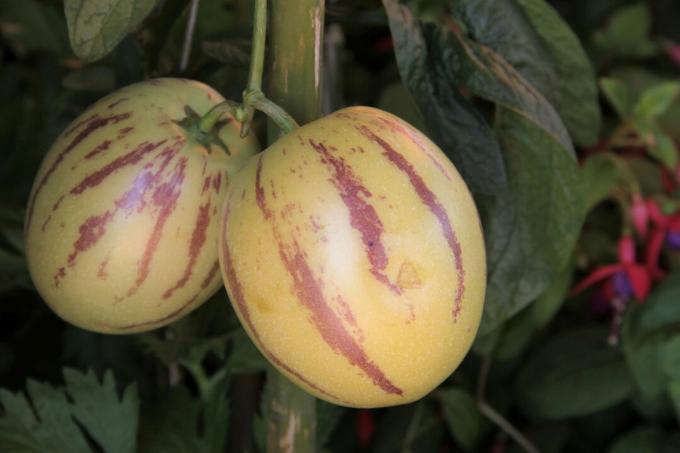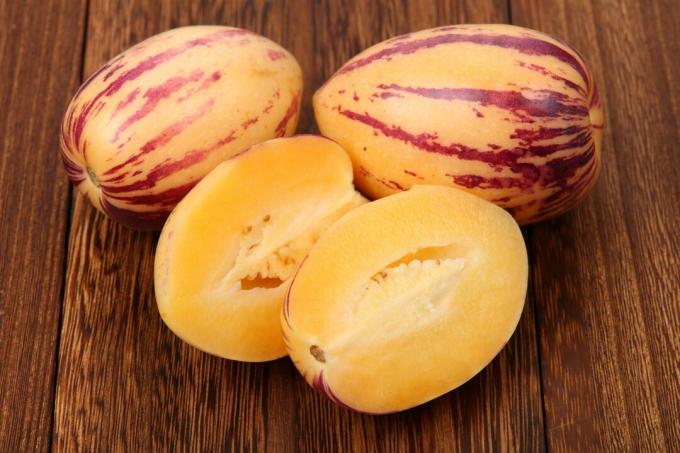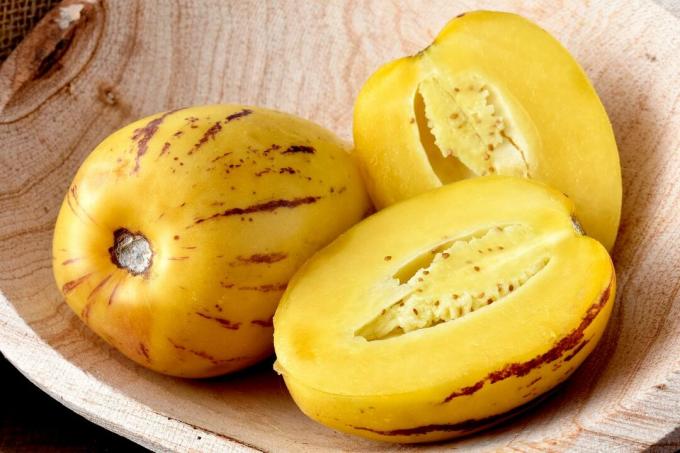The pepino (also melon pear) convinces with extraordinary fruits. Below you can find out how to grow the pear melon, when the melon pear is ripe and how the fruit tastes.

Pepinos are also known as pear melon or melon pear because they taste like an exotic mixture of both fruits. We introduce you to the Pepino and give tips on cultivation and harvesting.
contents
- Pepino: characteristics and origin
- Overview of the Pepino varieties
-
Plant melon pear
- The right Pepino location
- This is how planting works
- Care of the melon pear: This is important to note
- Overwinter melon pear
- Multiply melon pears: this is how it works
- Melon pear: harvest and use
Pepino: characteristics and origin
The Pepino (Solanum muricatum) belongs to the nightshade family (Solanaceae) and is closely related to tomato (Solanum lycopersicum), chili (capsicum) and eggplant (Solanum melongena) related. It originally comes from South America and requires warm temperatures. That is why we often only grow it as an annual, although it is actually a perennial plant.
Pepinos reach a height of 60 to 120 centimeters, in exceptional cases up to 150 centimeters. Externally, they resemble chilli plants, the leaves are lanceolate to spoon-shaped and dark green in color. The flowers of the pepino, on the other hand, are similar to those of aubergines, they are fivefold and have violet stripes. The flowering period begins in June and lasts until September.
The fruits of the pepino form one after the other and ripen from July to October. The melon pears are elliptical, apple-shaped or egg-shaped, grow to an average size of 10 to 20 centimeters and weigh up to 400 grams. When ripe, the two-chambered berry has a light yellow to sun-yellow color with dark violet vertical stripes. The soft and tasty flesh is golden yellow to yellow-orange in colour. The pepino fruit can be eaten raw or with the skin on. The taste of the ripe melon pear is sweet and fruity, reminiscent of melon and pear.

Overview of the Pepino varieties
There are only a few varieties of Pepinos, the heat-loving plant is usually offered without a variety designation. Nevertheless, we would like to give you a small overview of the varieties.
- 'Sugar Gold': Melon pear with overhanging growth up to 100 cm. It is therefore ideal for a hanging traffic light. The golden-yellow, pear-sized fruits taste sweet and fruity.
- 'Copa': Late maturing Pepino with a growth height of around 100 cm. Ripe, tasty pear melons can be harvested from September to October.

Plant melon pear
Pepinos can be cultivated like small tomatoes because they have similar requirements in terms of location and care.
The right Pepino location
Pear melons prefer a permeable and nutrient-rich soil. The small plants are ideal for balcony gardens, traffic light plantings and keeping in pots. Pepinos prefer a sheltered, warm location. They are sensitive to cold and should only be planted out after the ice saints in mid-May.
This is how planting works
For planting in buckets, hanging baskets or balcony boxes, you should use a nutrient-rich potting soil such as ours Plantura organic tomato soil, Select. The loose texture and high compost content prevent waterlogging and at the same time store plant-available water after watering. Fill the substrate into the prepared planters. The pots should hold at least 5 liters of soil and have good drainage. Plant young Pepino plants you have bought or brought earlier into the ground, but not deeper than they were already in the pot. Press the soil all around and then water vigorously.
Care of the melon pear: This is important to note
The Pepino requires only a few care measures. It does not have to be pinched, but can branch out happily and form flowers. If the plant hangs in a certain direction, it should be supported with wooden or metal stakes. Pepinos are thirsty people and therefore need to be watered regularly. As a heavy feeder, the pear melon also requires increased nutrients.
Regular watering and fertilizing bring a rich harvest of pepino fruits. Both can be done with an organic liquid fertilizer like ours Plantura Organic Tomato & Vegetable Fertilizer, be combined. It is added to the irrigation water about once a week and applied together. The nutrients contained are thus flushed directly to the roots and can also quickly provide relief in the event of acute deficiency symptoms.
tip: If your Pepino plants are in a bed or greenhouse, you should apply a layer of mulch all around. The large, overhanging fruits are dry in this way and do not rot through contact with the ground.
Overwinter melon pear
The Pepino is basically a perennial plant that can also be overwintered here. The procedure is the same as with the Overwintering tomatoes. As soon as the temperatures fall permanently below 10 °C, the Pepinos should be put away for the winter. The plant as a whole is overwintered in the winter quarters in a light, cool place with seldom watering. Alternatively, cuttings can be overwintered.

Multiply melon pears: this is how it works
Pepino can be propagated by seeds or vegetatively by cuttings. The fruits of the ripe pear melon usually contain very few seeds, which can be removed, dried and stored for several years. These pepino seeds are grown early, namely from February, on the warm window sill and planted out from mid-May. In early summer, the propagation of the Pepino via cuttings is easier and also much faster. Cut about 10 cm long cuttings from the shoot tips and root them either in water or in light-colored potting soil enriched with sand and at about 20 °C. With a bit of luck, the young plants will flower in the same year or, after a successful hibernation, as a vigorous plant the following year.
Melon pear: harvest and use
The pear melon is harvested from July until the last fruits are ripe in October. As soon as the fruits feel soft to the touch and smell a little, they can be harvested. Melon pears should not be stored in the refrigerator, as they suffer from the cold, lose their flavor quickly and become mushy. At room temperature, the pear melons will keep fresh for a few weeks. You can eat Pepinos raw, prepare them as dessert and ice cream, or preserve them and cook them down. Chutney or a melon pear jam brings back the fruity taste of summer in winter. Melon pears are only poisonous when unripe and can cause stomach cramps and nausea due to the high solanine content.
Also the Tamarillo (Solanum betaceum) is a close relative of tomato, chilli and co. We present it in the profile and give tips on growing and harvesting the tree tomato.
